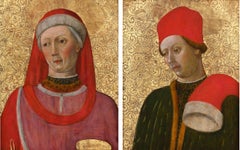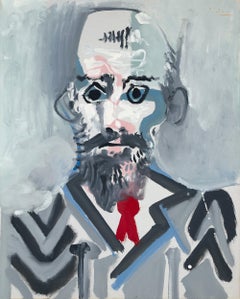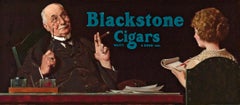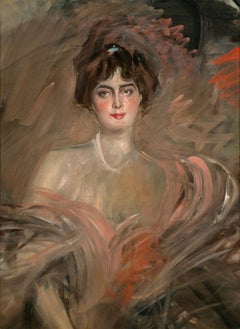Want more images or videos?
Request additional images or videos from the seller
1 of 8
Domenico TintorettoPortrait of a Venetian Senator attributed to Domenico Tintoretto17th Century
17th Century
$58,500List Price
About the Item
- Creator:Domenico Tintoretto (1560-1635, Italian)
- Creation Year:17th Century
- Dimensions:Height: 35 in (88.9 cm)Width: 29.25 in (74.3 cm)Depth: 2.5 in (6.35 cm)
- Medium:
- Movement & Style:
- Period:
- Condition:
- Gallery Location:New Orleans, LA
- Reference Number:Seller: 31-16941stDibs: LU1866941142
About the Seller
5.0
Vetted Professional Seller
Every seller passes strict standards for authenticity and reliability
Established in 1912
1stDibs seller since 2013
20 sales on 1stDibs
Typical response time: 4 hours
Authenticity Guarantee
In the unlikely event there’s an issue with an item’s authenticity, contact us within 1 year for a full refund. DetailsMoney-Back Guarantee
If your item is not as described, is damaged in transit, or does not arrive, contact us within 7 days for a full refund. Details24-Hour Cancellation
You have a 24-hour grace period in which to reconsider your purchase, with no questions asked.Vetted Professional Sellers
Our world-class sellers must adhere to strict standards for service and quality, maintaining the integrity of our listings.Price-Match Guarantee
If you find that a seller listed the same item for a lower price elsewhere, we’ll match it.Trusted Global Delivery
Our best-in-class carrier network provides specialized shipping options worldwide, including custom delivery.You May Also Like
19th Century Young Irish Woman with Feathered Hat
Located in Soquel, CA
Mid 19th Century portrait of a young Irish woman in c. 1570s dress with ruffle. Painted in the style of William Merritt Chase. Unsigned and unframed.
Category
Mid-19th Century Renaissance Portrait Paintings
Materials
Canvas, Oil
Copy of "Portrait of Beatrice dʼEste" by Leonardo da Vinci created 15th Century
Located in New York, NY
A masterful copy by an unknown artist, after the portrait of "Beatrice d'Este" by Leonardo Da Vinci also known as ‘Portrait of a Lady’ or ‘La Dama con la reticella di perle (The Lady With a Pearl Hairnet)’. The original work originally created in the 15th Century is currently on display in the Pinacoteca Ambrosiana Museum of Milan. Beatrice d'Este was the Duchess of Bari/Milan and was believed to be one of the most attractive princesses of the Renaissance. Her impeccable style won her many admirers throughout Italy and France, and she became a trendsetter of the highest order. This copy of the original painting, is an oil on canvas done in the 18th Century, and in this exquisite portrait, the artist has masterfully depicted the fine details with draped hair, pearls, royal dress, ornate headgear and sumptuous jewelry in front of a dark background. Once again, capturing the imagination with another enigmatic smile. It comes housed in an elegant period giltwood frame with ebonized trims and ready to be displayed with hanging wire on verso.
Art measures 28 x 18 inches
Frame measures 34.5 x 24.5 inches
There is much debate and controversy over who actually painted the "Beatrice d'Este" was it Leonardo da Vinci (1452–1519), or Giovanni Ambrogio de Predis (1455–1508). So we may never know who executed the original portrait which hangs in the museum, but that need not deter from an appreciation of its singularity. Following the portraiture convention established by painters of the Quattrocentro, the artist has chosen to portray his sitter in profile. In doing so, he magnificently captures the essence of his sitter, a girl on the threshold of womanhood. Bedecked in the adornments—silk, velvet, pearls and embroidery (brocade) crafted of spun gold threads—afforded her by birthright and marriage, Beatrice looks forward in noble serenity. And at the same time her profile with its upturned nose and slight smile betrays an innocence that must have been the basis of the oft-repeated epithet: la più zentil donna in Italia” (“the sweetest lady in Italy”).
It is believed the lady is Beatrice d'Este (1475-1497), duchess of Bari and later of Milan, the wife of Ludovico Sforza (known as "il Moro"). One of the most beautiful princesses of the Italian Renaissance, she was known for her good taste in fashion. Beatrice was a member of the Este-Sforza family, which joined by marriage two of the oldest reigning and already powerful houses in Italy. The house of Este, which held court in Ferrara, traced its lineage to the 11th century Dukes of Saxony and Bavaria. Beatriceʼs father, Ercole I ruled the Ferrara commune for 34 years, catapulting the city-state (and the Estes with it) to an unmatched level of economic prosperity and cultural prominence. The family was renowned for its love of letters and patronage of the arts.
The first time Leonardo da Vinci’s name resounded in the Ambrosiana, it was through the pen of its founder, Cardinal Federico Borromeo, who attributed this little panel to the great Master, describing it as “A portrait of a Duchess of Milan, by the hand of Leonardo”. Following the Cardinal’s statement, the portrait was for long assumed to depict Beatrice d’Este, the wife of Ludovico il Moro. However, scholars have recently been more cautious and vague in their statements, with regard to both the artist (anonymous Lombard or Emilian...
Category
18th Century Northern Renaissance Portrait Paintings
Materials
Canvas, Oil
$35,000
H 34.5 in W 24.5 in D 2.5 in
Original abstract oil painting by prominent searchable artist Steve McElroy.
By Steve McElroy
Located in Dallas, TX
This artist's butterfly work is in the current Veranda Magazine with Jan Showers.
"Girl with the Hermes Scarf" by Steve McElroy. Oil on canvas, 22 x 28 inches, painted 2025. This ...
Category
2010s Renaissance Figurative Paintings
Materials
Oil, Canvas
$1,500
H 28 in W 22 in D 0.5 in
Fine 17th C Italian Old Master Oil Painting Madonna & Infant Christ with Joseph
Located in Cirencester, Gloucestershire
The Holy Family
17th century Genoise School, unsigned as typical of the period
follower of Luca CAMBIASO
oil on canvas, unframed
canvas: 29.5 x 22 inches
inscribed verso
Provenance: ...
Category
17th Century Renaissance Figurative Paintings
Materials
Canvas, Oil
Allegory of Music Ste Cecilia School After Lorenzo Lippi
Located in Pasadena, CA
The painting is about the Florentine school and a seventeenth-century Italian school. Oil on canvas
After Lorenzo Lippi (1606–1665) who was a prominent Florentine Baroque painter a...
Category
17th Century Renaissance Figurative Paintings
Materials
Oil
Allegory of Music Ste Cecilia School After Lorenzo Lippi
Located in Pasadena, CA
The painting is about the Florentine school and a seventeenth-century Italian school. Oil on canvas without signature
After Lorenzo Lippi (1606–1665) who was a prominent Florentine...
Category
17th Century Renaissance Figurative Paintings
Materials
Oil
18th Century Italian Oil Madonna & Child with St. John the Baptist after Raphael
Located in Cirencester, Gloucestershire
Madonna and Child with St. John the Baptist
Italian artist, 18th century, after the earlier painting by Raphael
oil on wood panel, framed in an Empire, gilt moulded frame
Framed: 23 ...
Category
18th Century Renaissance Figurative Paintings
Materials
Oil
$4,253 Sale Price
30% Off
H 23 in W 22 in
Guardian Angel, 17th century Italian Old Master oil on copper
Located in Cirencester, Gloucestershire
Guardian Angel
Italian School, 17th century
Oil painting on copper, framed
Framed size: 12 x 10.5 inches
Fine quality early Italian Old Master oil on copper panel, dating to the 17t...
Category
17th Century Renaissance Portrait Paintings
Materials
Oil
$2,127 Sale Price
30% Off
H 12 in W 10.5 in D 1 in
Stylised Portrait, Peasant Girl, Impressionist Oil Painting
Located in Cirencester, Gloucestershire
Stylised Portrait, Peasant Girl, Impressionist Oil Painting
By European Schooled artist, Mid 20th Century
Oil painting on metal, framed
Framed size: 10.5 ...
Category
Mid-20th Century Renaissance Portrait Paintings
Materials
Oil
$567 Sale Price
30% Off
H 10.5 in W 8 in
Allegory of Music School After Lorenzo Lippi
Located in Pasadena, CA
After Lorenzo Lippi (Florence, May 6, 1606 - Florence, April 15, 1665) is a Baroque painter of the Florentine school and a seventeenth-century Italian poet.
Category
17th Century Renaissance Figurative Paintings
Materials
Oil
$24,000 Sale Price
20% Off
H 24.41 in W 31.5 in D 1.97 in
More From This Seller
View AllSaint Cosmas And Saint Damian Attributed To Bonifacio Bembo
By Bonifacio Bembo
Located in New Orleans, LA
Attributed to Bonifacio Bembo
c.1444-1477 Italy
Saint Cosmas and Saint Damian
Tempera on panel
These exceptionally rare early Renaissance panels of Saint Cosmas and Saint Damian are an extraordinary new discovery. Based on the research of art historians Marco Tanzi and Andrea de Marchi, it is believed that these represent the missing panels from the famed polyptych formerly displayed on the altar of the Chapel of San Nicola da Tolentino in the Church of Sant’Agostino in Cremona, Italy. To find two matching early Renaissance panels outside of a museum or church, particularly in such remarkable condition, is an extraordinary rarity.
The central and left-sided panels of the original five-part polyptych are currently in the collection of the Museo Civico Ala Ponzone in Cremona. These panels have luckily remained intact, and respectively portray the Madonna and Child Enthroned with Angels and Donor, Saint Nicholas of Tolentino (the chapel’s namesake) and Saint George.
While the present panels have since been reduced, that they belong to the Cremonese altarpiece is confirmed by a number of stylistic elements. All five panels contain the same rich decorative arabesque pattern on their stamped gold background, while the figures’ knurled haloes are identical in both their fineness of line and use of perspective. The proportions of the figures coincide perfectly; Saints Cosmas and Damian would have originally also been depicted as full-length figures, fitting into the vertical, Gothic style of the altarpiece.
According to the Christian religion, Saint Cosmas and Saint Damian were 3rd century physicians born in Arabia. Little is known about their lives except that they were reputedly twin brothers and that they were martyred in Syria during the persecution of Emperor Diocletian. It was believed that the saints were skilled in healing, and when their medicines failed, their faith and prayers could always perform miracles. Thus, the saints are often depicted with their medical equipment while wearing the traditional medieval doctor’s garb of crimson robes and distinctive round red hats.
The saints are similarly depicted in the present panels, though considering the manner in which they have been cut, their medical tools are not immediately evident. The saints were highly popular as patrons of wealthy families during the Gothic and Renaissance eras, particularly the Medici, and thus they occur frequently in art from the era. The twins, for instance, are found in the famed San Marco Altarpiece by Fra Angelico in the San Marco Museum (Florence), as well as in a set of Medici panels crafted by Filippo Lippi...
Category
15th Century and Earlier Renaissance Portrait Paintings
Materials
Tempera, Panel
Buste d'homme barbu by Pablo Picasso
By Pablo Picasso
Located in New Orleans, LA
Pablo Picasso
1881-1973 Spanish
Buste d'homme barbu
(Bust of a Bearded Man)
Signed "Picasso" (upper right) and dated "8.4.65" (en verso)
Oil on canvas
Pablo Picasso and his work transcend art history: they have achieved global celebrity within both academic circles and popular culture. More than any other artist, his ever-evolving, evocative style has come to define modern art of the 20th century, and to this day he continues to gain recognition. The most compelling of his works offer a glimpse into the psyche of the master himself, and the present work can be counted among these. Combining saturated color with a jarring simplicity, Buste d'homme barbu represents an important series of bearded men portraits that the artist composed during the last few years of his life. These works are among the most highly personal and intimate of his career, and they serve as remarkable examples of his mature style with their highly modern expressivity.
Many of Picasso's works from his last years capture the visage of his wife Jacqueline, who was his chief model during this period. In April, however, at his home studio in Mougins, France, Picasso changed direction and produced a series of individual portraits of men. His male subjects derive from various sources. Often they were self-referential portraits; often they referenced his father, Spanish painter José Ruiz...
Category
20th Century Post-Impressionist Portrait Paintings
Materials
Canvas, Oil
Blackstone Cigars
By Norman Rockwell
Located in New Orleans, LA
A charming relic of a bygone era, this rare oil is the work of the inimitable American illustrator, Norman Rockwell. The iconic artist’s ability to render the details and nuances of ...
Category
Early 20th Century Other Art Style Figurative Paintings
Materials
Canvas, Oil
Portrait of Emilienne Le Roy by Giovanni Boldini
By Giovanni Boldini
Located in New Orleans, LA
Giovanni Boldini
1842-1931 Italian
Portrait of Emilienne Le Roy
Oil on canvas
A dazzling display of Giovanni Boldini’s signature style, Portrait of Emilienne Le Roy captures the ...
Category
20th Century Modern Portrait Paintings
Materials
Canvas, Oil
La Carmencita by John Singer Sargent
By John Singer Sargent
Located in New Orleans, LA
John Singer Sargent
1856-1925 American
Stamped by artist's estate (en verso)
Oil on canvas
John Singer Sargent, widely regarded as one of history's most distinguished portraitists...
Category
19th Century Academic Portrait Paintings
Materials
Canvas, Oil
At the Mirror
By Frederick Carl Frieseke
Located in New Orleans, LA
the most important American Impressionists of his age. While many of his contemporaries focused on the landscape, Frieseke gained his inspiration from the figural, and in particular the theme of femininity. His works capture female figures engaging in traditionally feminine roles — strolling in the garden or posed in a domestic interior. At the Mirror...
Category
Early 20th Century Impressionist Nude Paintings
Materials
Oil, Canvas
Recently Viewed
View AllMore Ways To Browse
17th Century Venetian
Portrait Of Noble
17th Century Venetian Paintings
Venetian Dress
Painting Babushka
Peter Max Asia
Portuguese Painting Old
Princess Diana Signed
Puritan Oil Painting
Puyet Jose
Raimundo De Madrazo Y Garreta
Robert Menzies
Romero Britto Original
Santini Poncini
Sitting Bull Painting
Vintage Chesterfield Cigarettes
Vintage Sad Clown Painting
Warhol Self Portrait Green



